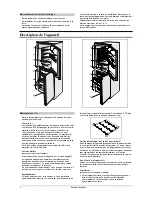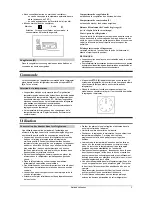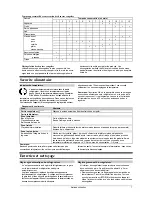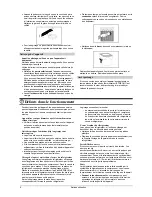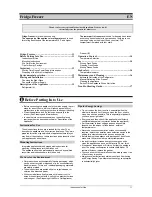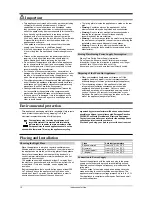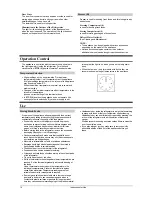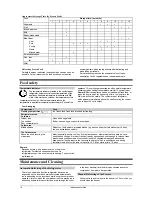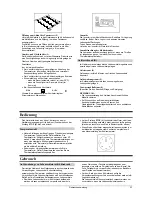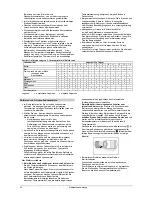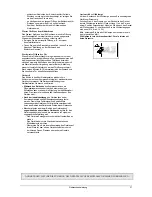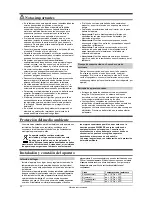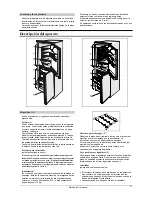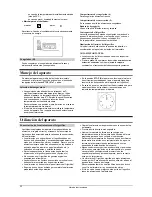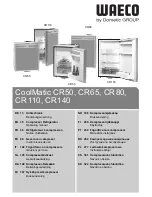
Instructions for Use
17
•
Few hours before defrosting set the thermostat to position
7
,
so that packages are well frozen. Reset the thermostat to
STOP (0)
position and disconnect the power supply. Empty
the freezer and take care that the packages remain frozen.
•
Insert the enclosed pipe into the groove in the bottom of the
appliance and place a vessel underneath to collect the
defrost water. Defrosting is accelerated if the door is left
open.
•
Avoid using defrosting sprays, as they may cause damage
to the plastic parts and may be hazardous to health.
Cleaning the Appliance
Disconnect the power supply before cleaning the
appliance.
Do not use coarse or aggressive cleaning agents as you can
damage the surface. Be careful to remove any cleanser agent
remaining after cleaning.
•
Clean the
exterior
with water and detergent.
Varnished surfaces are cleaned with soft cloth and an
alcohol based cleaning agent (for example glass cleaners).
You may also use alcohol (ethanol or isoprophylic alcohol).
The application of abrasive and specially aggressive
cleaners, such as the stainless steel cleaners, is not
appropriate for the cleaning of plastic and coated parts.
•
Remove the
detachable accesories
in the interior of the
appliance and clean it with water and liquid detergent.
Plastic parts cannot be washed in washing machine.
•
Wash the
interior
of the appliance with lukewarm water, in
which you added one or two spoonfuls of vinegar.
•
Every now and then wipe the
condenser
on the rear wall.
Use soft non-metal brush or vacuum cleaner.
•
Do not forget to clean also the defrost water
receptacle
above the refrigerator compressor (do not remove the
receptacle).
After cleaning, connect the appliance to power supply and
reload the packages.
Switch Off the Appliance When Not In Use
If you do not intend to use the appliance for a longer period, set
the thermostat knob to the
STOP (0)
position, disconnect the
power supply, take out the foods and defrost and clean the
appliance. Leave the door slightly open.
Trouble-Shooting Guide
During the service, you can come across some troubles that in
most cases result from improper handling of the appliance and
can easy be eliminated.
The Appliance Fails to Operate After connecting to the
Mains Supply
•
Check the supply in the outlet socket and make sure the
appliance is switched on (thermostat in operating position).
Continuous Operation of the Refrigerating System
•
The door was frequently opened or it was left opened for too
long.
•
The door is not properly closed (the door may sag, the
gasket may be polluted or damaged).
•
Perhaps you have overloaded the appliance with fresh
foods.
•
The reason may be inadequate ventilation of the compressor
and condenser (assure adequate air circulation and wipe off
the condenser).
•
Continuous operation button activated (see section Freezing
of Food).
Ice Formation on the Inner Rear Wall
As long as the defrost water runs to the channel and through
the opening to the drain pan on the compressor, automatic
defrosting of the appliance is assured.
In case the ice formation on the inner back wall is increased (3-
5 mm), ice should be manually defrosted.
Set the thermostat knob to
STOP (0)
position and leave the
door open. Never use electric devices for defrosting and do not
scrape the ice or frost layer with sharp objects.
After completed defrosting, turn the knob to desired position
and close the refrigerator door.
The cause of increased ice formation may be one of the
following:
−
the door does not seal well (clean the gasket if it is
contaminated, or replace it if it is damaged);
−
the door was frequently opened or it was left opened for
too long;
−
the food stored in the refrigerator was warm;
−
the food or dish is touching the inner back wall.
Water is Leaking From the Refrigerator
In case the discharge water outlet is clogged, or the defrost
water drips over the channel, water leaks from the refrigerator.
•
Clean the clogged opening, for example with a plastic straw.
•
Manually defrost the increased ice layer. See "Ice Formation
on the Inner Back Wall".
The Freezer Door is Hard to Open
If you want to open the door that has just or recently been
closed, you may find it hard to open. The reason why this
happens is, that when you open the door, warm air gets into
the appliance and when it is getting cool, the underpressure
seals the door. After few minutes (5-10), the door can easily be
opened.
Noise
Cooling in refrigerating-freezing appliances is enabled by the
refrigerating system with compressor, which produces noise.
How noisy the appliance is depends on where it is placed, how
it is used and how old the appliance is.
•
During the operation
of the compressor the noise of liquid
is heard and when the compressor is not operating, the
refrigerant flow is heard. This is a normal condition and it
has no influence whatsoever on the lifetime of the appliance.
•
After starting the appliance,
the operation of the
compressor and the refrigerant flow may be louder, which
does not mean that something is wrong with the appliance


